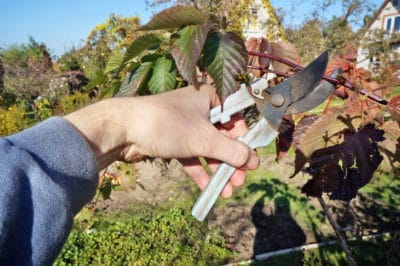Things You’ll Need
- 4-inch plastic nursery pots with drainage holes, one for each cutting
- Clean, sharp bypass pruners
- Pre-moistened, soilless rooting medium
- Plastic cup or jar
- Wooden dowel or pencil a bit larger than your cuttings
- Moist rooting hormone
- Sharp knife
- Watering can with water
- 1-quart, clear plastic bag for each potted cutting
- Twist ties
Fill your pots loosely with the pre-moistened, soilless potting mix. It’s essential if you want to grow fungus- and disease-free cuttings.
Collecting Your Cuttings
Blackberry bushes propagate most reliably from stem cuttings harvested in spring and transplanted in fall.
Take Primocane Cuttings
Take your cuttings from primocanes, the first-year canes that won’t bear fruit. Make a clean, sharp cut about 6 inches from each canes’ leafy end, just below a leave node or bud. The ideal cutting has between five and six buds.
Expert gardener’s tip: Some primocanes are long enough to yield more than one cutting.
Prepping Your Cuttings
- Step 1. Moisten the rooting hormone. Pour enough of it to coat the bases of the cuttings into a clean jar.
- Step 2. Strip all the cuttings’ flowers and flower buds, and all but their top two or three leaves.
- Step 3: Poke a 1- to 2-inch hole in the center of each pot’s medium with a pencil or dowel.
- Step 4. Scrape the bottom 1 inch of the cuttings lightly with a knife.
- Step 5. Swish the scraped portions through the rooting hormone.
Planting
Insert the cuttings into their planting holes with two buds below the soil line. Firm the soil to secure them, water lightly and set the pots in clear plastic bags.
Blow air the bags so the plastic doesn’t touch the cuttings and encourage mold. Seal them with twist ties and set them in a bright area out of direct sun.
Check the cuttings daily. Water as needed to keep the medium moist while they grow roots and become full-fledged blackberry plants. Keep them in their containers until transplanting them to their permanent homes in fall.
